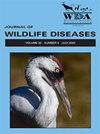Chemical Immobilization of Red Serows (Capricornis rubidus) with Ketamine and Medetomidine.
IF 1.2
4区 农林科学
Q3 VETERINARY SCIENCES
引用次数: 0
Abstract
The red serow (Capricornis rubidus) is a solitary, cryptic, forest-dwelling goat-antelope species from Asia, with very limited veterinary and health information. We report on the chemical immobilization of three red serows by using medetomidine (0.03 mg/kg) and ketamine (3 mg/kg). This combination may be useful for chemical capture and field anaesthesia of these animals.
氯胺酮与美托咪定化学固定红丝蚕的研究。
红雪羚(Capricornis rubidus)是一种独居的、隐蔽的、生活在森林中的山羊羚羊,来自亚洲,兽医和健康信息非常有限。本文报道了美托咪定(0.03 mg/kg)和氯胺酮(3 mg/kg)对3种红血清的化学固定化。这种组合可能对这些动物的化学捕获和野外麻醉有用。
本文章由计算机程序翻译,如有差异,请以英文原文为准。
求助全文
约1分钟内获得全文
求助全文
来源期刊

Journal of Wildlife Diseases
农林科学-兽医学
CiteScore
2.70
自引率
0.00%
发文量
213
审稿时长
6-16 weeks
期刊介绍:
The JWD publishes reports of wildlife disease investigations, research papers, brief research notes, case and epizootic reports, review articles, and book reviews. The JWD publishes the results of original research and observations dealing with all aspects of infectious, parasitic, toxic, nutritional, physiologic, developmental and neoplastic diseases, environmental contamination, and other factors impinging on the health and survival of free-living or occasionally captive populations of wild animals, including fish, amphibians, reptiles, birds, and mammals. Papers on zoonoses involving wildlife and on chemical immobilization of wild animals are also published. Manuscripts dealing with surveys and case reports may be published in the Journal provided that they contain significant new information or have significance for better understanding health and disease in wild populations. Authors are encouraged to address the wildlife management implications of their studies, where appropriate.
 求助内容:
求助内容: 应助结果提醒方式:
应助结果提醒方式:


